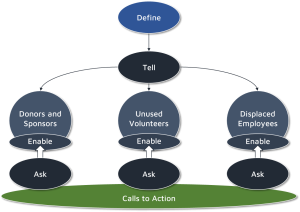7
People are struggling during Covid-19. Some who were donating have actually become non-profit clients as their jobs disappear and incomes dry up. Some non-profits can’t use all of their volunteers, and may have furloughed staff. As a result, organizations’ budgets are in disarray, and the services of valuable human resources are lost.
It’s tough to ask for money under these conditions, and equally difficult to expect those who non-profits have laid off to turn around and give something back to their organizations. As challenging as it is, it’s also necessary, and can be very productive. Reaching out to connections can help generate support non-profits need.
The key lies in effectively defining, telling, asking, and enabling (Figure 11, following page). However, non-profits need more persuasive during Covid-19 than ever before:[1]
- Being clear about the “ask”—Knowing just what it is that a non-profit is looking for from each group.
- Informing connections of the need—Articulating why the organization needs the defined support.
- Making the request—Giving a direct “call to action” for people to provide exactly what is required.
- Enabling the “give”—Making it simple for the non-profit’s connections to respond to the call.
Figure 12—Model for Leveraging Connections During Covid-19

Figure 13, below, provides a more detailed example of how non-profits can apply this model during Covid-19 to generate the support they need from each group.

Figure 13—Example of Approaching Connections for Support
| Element | Donors and Sponsors | Unused Volunteers | Displaced Workforce |
| Define |
|
|
|
| Tell |
|
|
|
| Ask |
|
|
|
| Enable |
|
|
|
Donors and sponsors can give and advocate on a non-profit’s behalf to generate donations from their friends and colleagues. Volunteers can be “repurposed” to provide other operational assistance,[2] and may also donate as well. The displaced workforce can “stick around” but, if they are unable to, can help find qualified replacements.
There are at least six major characteristics in effectively leveraging connections during Covid-19. They generally apply to every group, although the details may differ:
- Diversity—When possible, multiple representatives of non-profits conducting outreach (e.g., Boards, executives, staff, volunteers, Human Resources). Leadership should have a significant presence, and others should provide alternative perspectives in communicating with different connections.
- Transparency—It is always good to be open and honest, and this is especially true in times of uncertainty. People need to know what’s going on, how they are affected, and organizations’ plans. They are also much more likely to respond positively when they feel a non-profit is being forthright.
- Clarity—This is no time for confusion! Messages must be clear, compelling, and easy for people to digest. Effective engagement requires audiences understand the situation, the urgency of responding and how they should help non-profits, so individuals do not have to interpret it for themselves.
- Persuasion—Given the unique impacts of Covid-19 on different groups, non-profits need to be more convincing than ever. Why people should give, contribute their talents, stay available for re-employment, or give positive feedback to others has to capture their interests and attentions.[3]
- Directness—Non-profits need to state what they so that audiences don’t have to guess the specifics of what’s being asked (e.g., donation amounts, timing, methods, messaging). This makes defining the need up front particularly important, as well as providing the means for people to contribute.
- Repetition—Regular, frequent communications are essential. Donors may not respond to a first request. In fact, they are more likely to do so with multiple “touches” from different people sharing unique perspectives. Repetition also helps volunteers and staff feel valued, even when not fully engaged.

There are people with both the desire and capacity to help non-profits through the Covid-19. They are existing and new donors and sponsors, volunteers who can’t be deployed, and furloughed staff—people non-profits need to keep engaged in order to be successful. Leveraging these connections is crucial, now and for the future.
Go to Session 5 presentation and recordings for a more detailed discussion
- Anecdotally, those who “have” are tending to give more during this crisis, especially to “front line” non-profits. ↵
- Non-profits may be able to use certain volunteers to help complete deferred initiatives. They can also be very effective in donor outreach. ↵
- Storytelling—telling audiences about real people who are impacted by Covid-19, and letting them know the effects of their efforts and/or contributions—is a proven way to produce the desired responses. ↵
